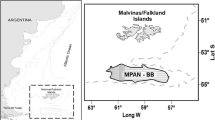Synopsis
Stomach contents of three Latimeria chalumnae dissected in Japan support the hypothesis that the coelacanth is a predominantly nocturnal bottom or near-bottom drift feeder. Prey items identified in this study (Ilyophis brunneus, Cephaloscyllium sufflans and Beryx decadactylus) and those reported previously are mostly benthic or epibenthic dwellers. The drifting of the coelacanth in a headstanding posture would account for the easy capture of prey that moves within or just above the bottom strata at night.
Similar content being viewed by others
References cited
Bass, A.J. 1986. Scyliorhinidae. pp. 89–95. In: M.M. Smith & P.C. Heemstra(ed.) Smiths' Sea Fishes, Macmillan, Johannesburg.
Bemis, W.E. & T.E. Hetherington. 1982. The rost[r]al organ of Latimeria chalumnae: morphological evidence of an electroreceptive function. Copeia 1980. 467–470.
Blache, J., M.L. Bauchot & L. Saldanha. 1973. Synaphobranchidae. pp. 252–253. In: J.C. Hureau & Th. Monod (ed.) Clofnam I, UNESCO, Paris.
Bruton, M.N. & S.E. Coutouvidis. 1991. An inventory of all known specimens of the coelacanth Latimeria chalumnae, with comments on trends in the catches. Env. Biol. Fish. 32: 371–390. (this volume)
Castle, P.H.J. 1986. Synaphobranchidae. pp. 188–191. In: M.M. Smith & P.C. Heemstra(ed.) Smiths' Sea Fishes, Macmillan, Johannesburg.
Fraser, T.H. 1972. Comparative osteology of the shallow water cardinal fishes (Perciformes: Apogonidae) with referene to the systematics and evolution of the family. Ichthyol. Bull. J.L.B. Smith Inst. Ichthyol. 34: 1–105.
Fricke, H., K. Hissmann, J. Schauer, O. Reinicke, L. Kasang & R. Plante. 1991. Habitat and population size of the coelacanth Latimeria chalumnae at Grand Comoro. Env. Biol. Fish. 32: 287–300. (this volume)
Hayashi, M. 1984. Coranthus polyacanthus (Vaillant). pp. 145. In: H. Masuda, K. Amaoka, C. Araga, T. Uyeno & T. Yoshino(ed.) The Fishes of the Japanese Archipelago, Tokai University Press, Tokyo.
Heemstra, P.C. 1986a. Berycidae. pp. 409–410. In: M.M. Smith & P.C. Heemstra(ed.) Smiths' Sea Fishes, Macmillan, Johannesburg.
Heemstra, P.C. 1986b. Polymixiidae. p. 432. In: M.M. Smith & P.C. Heemstra(ed.) Smiths' Sea Fishes, Macmillan, Johannesburg.
Hulley P.A. 1986. Order Myctophiformes. pp. 282–322. In: M.M. Smith & P.C. Heemstra(ed.) Smiths' Sea Fishes, Macmillan, Johannesburg.
Katayama, K. 1984. Symphysanodontidae p. 138. In: H. Masuda, K. Amaoka, C. Araga, T. Uyeno & T. Yoshino(ed.) The Fishes of the Japanese Archipelago, Tokai University Press, Tokyo.
Machida, Y. 1984. Ilyophis brunneus Gilbert. p. 26. In: H. Masuda, K. Amaoka, C. Araga, T. Uyeno & T. Yoshino(ed.) The Fishes of the Japanese Archipelago, Tokai University Press, Tokyo.
McAllister, D.E. 1971. Old four legs: a ‘living fossil’. Mus. Natl. Sci. Nat. Coll. Odyssey Ser. 1: 1–25.
McCosker, J.E. 1979. Inferred natural history of the living coelacanth. pp. 17–24. In: J.E. McCosker & M.D. Lagios (ed.) The Biology and Physiology of the Living Coelacanth, Occ. Pap. Calif. Acad. Sci. 134, San Francisco.
Millot, J. 1954. New facts about coelacanths. Nature 174: 426–427.
Millot, J. & J. Anthony. 1958. Crossoptérygiens actuels Latimeria chalumnae. pp. 2553–2597. In: P.-P. Grassé (ed.) Traité de Zoologie, Vol. 13, Agnathes et Poissons, Anatomie, Ethologie, Systématique, Masson, Paris.
Nielsen, J. 1973. Berycidae. p. 337. In: J.C. Hureau & Th. Monod(ed.) Clofnam I, UNESCO, Paris.
Smith, J.L.B. 1953. The second coelacanth. Nature 171: 99–107.
Smith, J.L.B. 1958. Old fourlegs. Second Edition. Pan Books Ltd., London. 284 pp.
Suyehiro, Y., T. Tsutsumi & T. Uyeno. 1984. On dissection of coelacanth, Latimeria chalumnae. pp. 12–13. In: Proc. 1st Symp. on Coelacanth Studies, Tokyo, 1984, Japan Sci. Comm. of Coelacanth Studies, Tokyo.
Suzuki, N., Y. Suyehiro & T. Hamada. 1985. Initial report of expeditions for coelacanth - Part I- Field studies in 1981 and 1983 Sci. Papers Coll. Arts Sci. Univ. Tokyo 35: 37–79.
Uyeno, T. 1989. Investigating the ecology of the coelacanth based on feeding habits. Newton Graphic Science Magazine 9 (13): 20–21. (In Japanese).
Uyeno, T. 1991. Observation on locomotion and feeding of released coelacanths, Latimeria chalumnae. Env. Biol. Fish. 32: 267–273. (this volume)
Author information
Authors and Affiliations
Rights and permissions
About this article
Cite this article
Uyeno, T., Tsutsumi, T. Stomach contents of Latimeria chalumnae and further notes on its feeding habits. Environ Biol Fish 32, 275–279 (1991). https://doi.org/10.1007/BF00007460
Received:
Accepted:
Issue Date:
DOI: https://doi.org/10.1007/BF00007460




